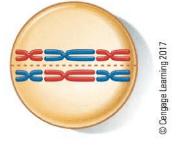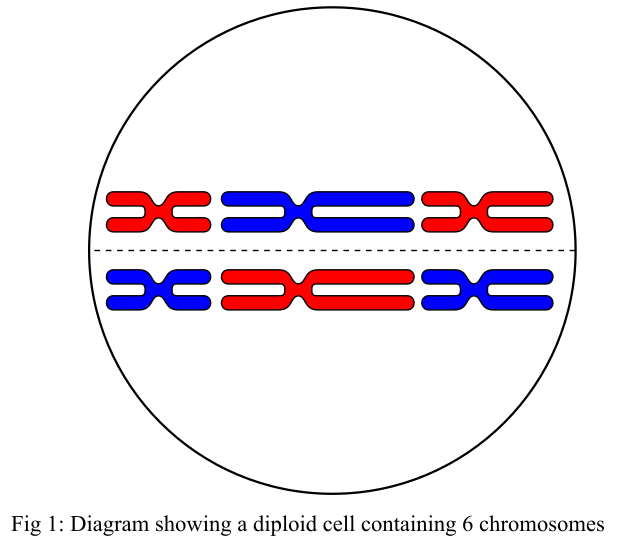
Concept explainers
The chromosome constitution number of this individual is

This drawing represents:
a. mitotic metaphase.
b. meiotic metaphase I.
c. meiotic metaphase II.
d. a gamete.
e. sixnonhomologous chromosomes.
Introduction:
The cell cycle consists of two main divisions known as mitosis and meiosis. Mitosis is the first division during the cell cycle in which the number of chromosomes remains same as the number of chromosomes in the parent cell; on the contrary, in meiosis, the number of chromosomes gets reduced to half.
Answer to Problem 1TYK
Correct answer:
Metaphase 1 of meiosis.
Explanation of Solution
Justification for the correct answer:

Option (b) is meiotic metaphase 1. There are two meiotic divisions after mitosis, namely, meiosis 1 and meiosis 2. During the meiosis 1, the paired chromosomes, also known as bivalent, arrange themselves on the metaphase plate. These paired chromosomes align at the middle of the plate and get attached to the meiotic spindle. The spindle is formed from the structure of the protein, which is responsible for dividing the genetic material in the cell. Hence, option (b) is correct.
Explanation for the incorrect answer:
Option (a) is metaphase in mitosis. Mitosis is the first part of the cell cycle that takes place before the meiosis. Metaphase stage in mitosis involves the arrangement of most condensed chromosomes and these chromosomes then get coiled at this stage. During the metaphase stage of meiosis, the chromosomes are not paired. So, it is an incorrect option.
Option (c) is metaphase 2 phase of meiosis 2. The chromosomes in the meiosis 2 are similar to the chromosomes found in the metaphase stage of mitosis. During the meiosis 2, the chromosomes get condensed and attach themselves to the spindles arising from the centromere present at the opposite poles. These condensed chromosomes are aligned on a metaphase plate but they are in a condensed form. So, it is an incorrect option.
Option (d) is a gamete. During fertilization fusion of one haploid gamete with another haploid gamete results in the formation of a diploid zygote. Number of chromosomes in a haploid cell is 23, two haploid cells fuse together to form a diploid cell. During meiosis number of chromosomes are reduced to 23 from 46 chromosomes. So, it is an incorrect option.
Option (e) states that number of non-homologous chromosomes is 6. Paired chromosomes are the one in which one chromosome is a homolog to another chromosome. These paired chromosomes have the same gene content and possess the same morphology as well. Non-homologous chromosomes are paired chromosomes in which both the chromosomes possess a different gene content. So, it is an incorrect option.
Hence, options (a), (c), (d), and (e) are incorrect.
Therefore, it may be concluded that in the metaphase division of meiosis 1 alignment of paired chromosomes on the metaphase plate takes place. These paired chromosomes get attached to the spindle fibers during this (metaphase 1) stage.
Want to see more full solutions like this?
Chapter 11 Solutions
Biology: The Dynamic Science (MindTap Course List)
- If a diploid organism has 14 chromosomes (2n=14) a. How many chromosomes will its gametes have? b. After meiosis I during gamete formation, how many chromosomes are in each daughter cell? c. After meiosis I during gamete formation, how many chromatids are in each daughter cell?arrow_forwardimagine a giraffe whose diploid is 30. A) what # of chromosomes will be present in a somatic cell at prophase of mitosis? B) what will be the # of chromosomes present in a somatic cell at prophase 2 of meiosis?arrow_forwardIf the diploid number of chromosomes is 10, which of the followinng would be present in metaphase of meiosis II? a. 5 dyads. b. 10 tetrads c. 10 dyads d. 5 tetrads.arrow_forward
- A) Give the diploid number of this organism. B) Is it mitosis or meiosis? Give two (2) elements on which you base your reasoning. C) Identify this mystery phase of the cell cycle. D) How many daughter cells will be produced at the end of the process and how many chromosomes (in numbers) will they contain? E) How does this process ensure the genetic variability of individuals of the species? Your answer must be based on two (2) different elements.arrow_forwardAn error occurred during meiotic cell division, and a human egg has an extra copy of chromosome 21. That egg was fertilized by a normal sperm to create an embryo. This would lead to an individual A) who was tetraploid B) who would be normal in chromosomal number C) who had trisomy D) who was triploidarrow_forwardConsider a diploid cell from an unknown organism that undergoes meiosis. The four gametes produced have 8, 8, 7, and 5 chromosomes. When did nondisjunction occur? a.Meiosis I and II b.Only meiosis I c.Mitosis d.Only meiosis II e.Nondisjunction did not occurarrow_forward
- which of these could lead to the mistake evident in the karyotype? A) a failure of cytokinesis after meiosis I in gamete formation B) a nondisjunction in meiosis II in gamete formation C) crossing over in meiosis ! in gamete formation D) fertilizaton by two sperm in zygote formationarrow_forwardA diploid male organism has two homologous chromosomes. A and B are from its maternal parent, while A’ and B’ are from its paternal parent. Draw the chromosomes at the following stages: a, anaphase of mitosis b. anaphase of the first meiotic division c, anaphase of the second meiotic division If the same chromosomes were involved in meiosis in a female, would the kind of egg nuclei produced be different from the sperm nuclei? Why?arrow_forwardIn human spermatogenesis, mitosis of a stem cell gives rise to one cell that remains a stem cell and one cell that becomes a spermatogonium. (a) Draw four rounds of mitosis for a stem cell, and label the daughter cells. (b) For one spermatogonium, draw the cells it would produce from one round of mitosis followed by meiosis. Label the cells, and label mitosis and meiosis. (c) Explain what would happen if stem cells divided like spermatogonia.arrow_forward
- For which of the following is the number the same in humanmales and females?(A) interruptions in meiotic divisions(B) functional gametes produced by meiosis(C) meiotic divisions required to produce each gamete(D) different cell types produced by meiosisarrow_forwardConsider a diploid cell from an unknown organism that undergoes meiosis. The four gametes produced have 8, 8, 7, and 5 chromosomes. When did nondisjunction occur? a. Only meiosis I b. Mitosis c. Meiosis I and II d. Nondisjunction did not occur e. Only meiosis II Clear my choicearrow_forwardA meiotic-nondisjunction causes trisomy 8 in a newborn. If two of the three copies of chromosome 8 are identical, at what point during meiosis did nondisjunction take place? Explain how you arrived at this answer.arrow_forward
 Biology: The Dynamic Science (MindTap Course List)BiologyISBN:9781305389892Author:Peter J. Russell, Paul E. Hertz, Beverly McMillanPublisher:Cengage Learning
Biology: The Dynamic Science (MindTap Course List)BiologyISBN:9781305389892Author:Peter J. Russell, Paul E. Hertz, Beverly McMillanPublisher:Cengage Learning Concepts of BiologyBiologyISBN:9781938168116Author:Samantha Fowler, Rebecca Roush, James WisePublisher:OpenStax College
Concepts of BiologyBiologyISBN:9781938168116Author:Samantha Fowler, Rebecca Roush, James WisePublisher:OpenStax College Biology Today and Tomorrow without Physiology (Mi...BiologyISBN:9781305117396Author:Cecie Starr, Christine Evers, Lisa StarrPublisher:Cengage Learning
Biology Today and Tomorrow without Physiology (Mi...BiologyISBN:9781305117396Author:Cecie Starr, Christine Evers, Lisa StarrPublisher:Cengage Learning Human Heredity: Principles and Issues (MindTap Co...BiologyISBN:9781305251052Author:Michael CummingsPublisher:Cengage Learning
Human Heredity: Principles and Issues (MindTap Co...BiologyISBN:9781305251052Author:Michael CummingsPublisher:Cengage Learning




